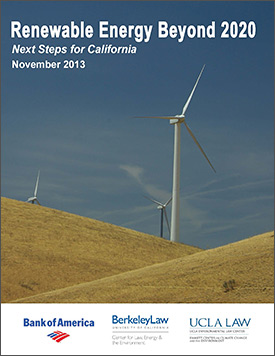
By: Susan Gluss
California must require utilities to increase the amount of renewable power that feeds the state’s electrical grid or risk stalling the clean energy market, according to top industry leaders. Their viewpoints are summarized in a new report: Renewable Energy Beyond 2020, a joint publication of the UC Berkeley and UCLA Schools of Law.
California is on course to meet and even exceed its goal of procuring 33 percent of its energy from renewable sources like solar and wind power by 2020. That target, known as the Renewable Portfolio Standard (RPS), was set by Gov. Jerry Brown two years ago. But with utilities poised to meet it, they have little incentive to sign new renewable energy contracts, according the report’s lead author and climate change research fellow, Ethan Elkind.
“The success of state policies may ironically be contributing to a stalled market for renewables,” Elkind said. “We need to boost our renewable energy goal to 51 percent or more by 2030, to maintain our momentum.”
The report’s recommendations represent a consensus among some of California’s leading renewable energy developers, finance experts, advocates, utility and business executives, and public officials. Convened together at a workshop earlier this year at UC Berkeley, the group discussed ways the state could meet higher standards for renewable energy while lowering emissions that cause climate change.
Elkind, the workshop organizer, said the state needs to link an increase in renewables to a reduction in greenhouse gas emissions (GHG) “to avoid the worst impacts of climate change.” The electricity sector is one of the largest sources of GHG, contributing nearly 20 percent of statewide emissions. California’s long-term goal is to reduce these pollutants to 80 percent below 1990 levels by 2050.
“We need to balance our energy resources without generating more pollutants,” Elkind said. “We don’t want to fill in peaks and valleys of intermittent renewable energy—due to the sun not shining or the wind not blowing—with natural gas and costly and dirty fossil fuels.”
Integrated planning is essential for the state to achieve a new renewable portfolio standard “without jeopardizing the reliability of the electricity grid,” said workshop facilitator Steven Weissman, who leads the energy program at Berkeley Law’s Center for Law, Energy, & the Environment.
For ratepayers, the goal is a seamless transition to cleaner energy sources.
“The electricity grid is a single, big machine that always must stay in balance,” Weissman said. “From an environmental perspective, consumers should care deeply about the sources of their electric power. But they want to know that cleaner sources of power are also dependable. Grid planners can maintain reliability without burning fossil fuels. They will need encouragement from policy leaders to make it happen.”
Workshop participants flagged key barriers to a higher renewable energy standard. These barriers include:
- absence of a dedicated agency to efficiently plan for and finance the necessary grid upgrades and technologies;
- insufficient planning, coordination, and research by grid operators, utilities and policy makers; and
- lack of any requirement to integrate intermittent renewable energy into the electrical grid without increasing greenhouse gas emissions.
To overcome these barriers, solutions include:
- new requirements that pair renewables with necessary grid upgrades, as well as benchmarks and metrics to ensure cost-effectiveness, reliability, and reduced emissions of greenhouse gases;
- in-depth government and utility planning and research, including a cost-benefit analysis of various renewable scenarios and an updated state energy action plan;
- a priority among operators to reduce emissions of greenhouse gases that might occur when integrating intermittent renewable energy into the grid; and
- greater integration of other regions into the California grid, possibly through the creation of a regional energy-imbalance market.
If these broad goals are met, California could receive more renewable, flexible, and reliable electric service in the coming decades, with lowered greenhouse gas emissions and expanded consumer choice, according to the report.
Renewable Energy Beyond 2020 is the twelfth in a series of reports on how business leaders and policy makers can address climate change. The workshops and reports are sponsored by Bank of America and produced by the Emmett Center on Climate Change and the Environment and the Environmental Law Center at UCLA School of Law, and Berkeley Law’s Center for Law, Energy & the Environment.